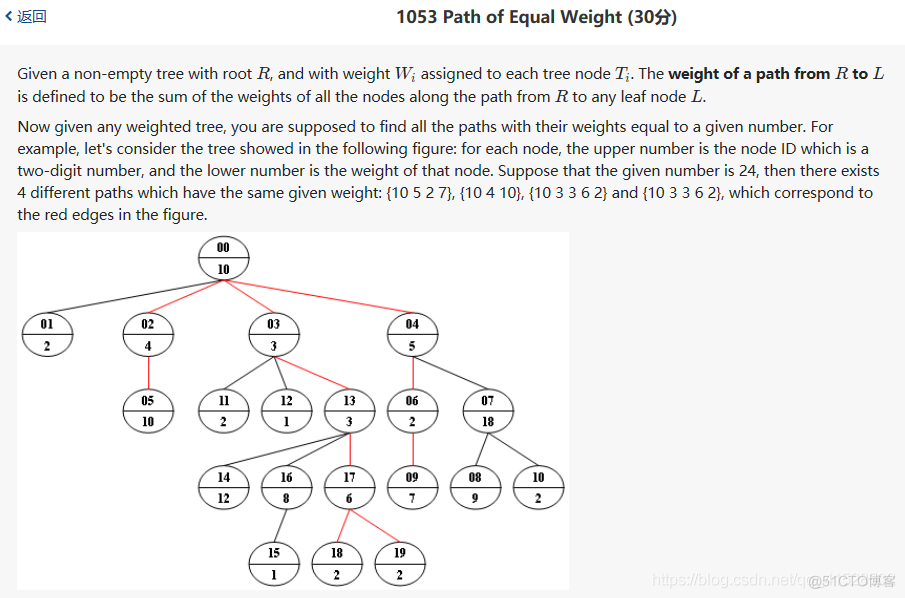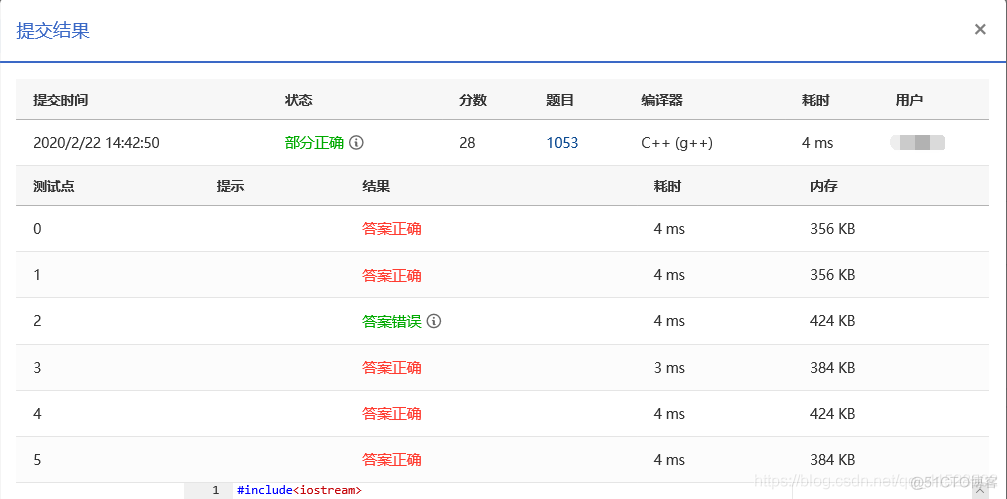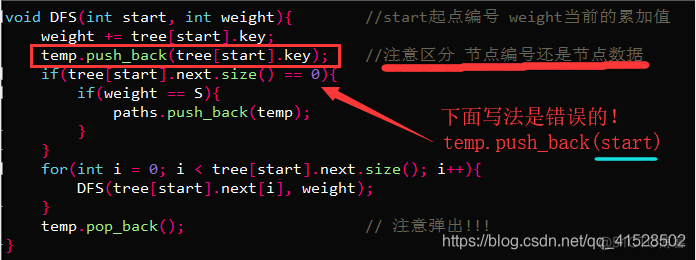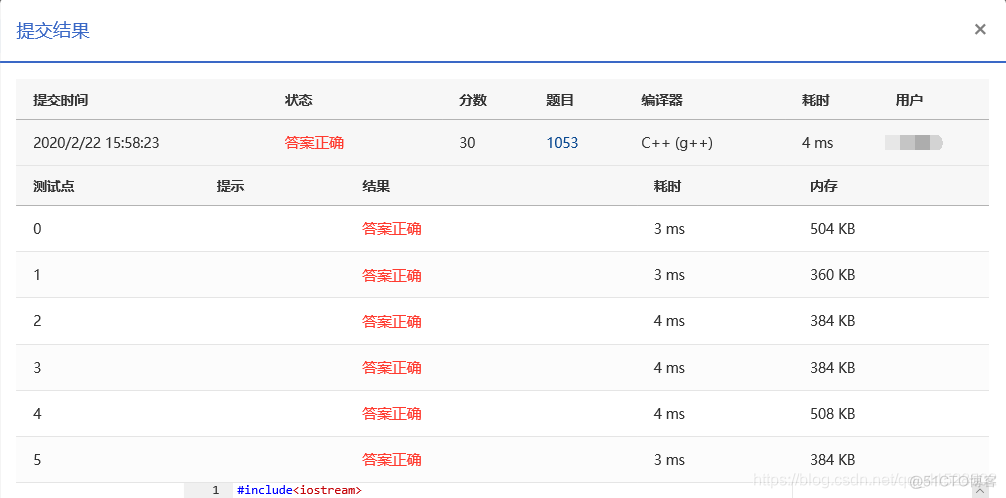目录
1,题目描述
题目大意
输入
输出
2,思路
数据结构
如何排序
如何设计DFS算法
3,心路历程
4,代码
1,题目描述


Sample Input:
20 9 2410 2 4 3 5 10 2 18 9 7 2 2 1 3 12 1 8 6 2 200 4 01 02 03 0402 1 0504 2 06 0703 3 11 12 1306 1 0907 2 08 1016 1 1513 3 14 16 1717 2 18 19
Sample Output:
10 5 2 710 4 1010 3 3 6 210 3 3 6 2题目大意
给出一棵树,每个节点对应一个权值和一个编号。另外给出一个数字S,求出所有从根节点到叶子节点的权值之和为S的路径,并输出路径中各节点的权值。若路径不唯一,则按照数组从大到小有序输出。
输入
输出
2,思路
设计结构体存放节点数据。利用vector存储这棵树。对树进行DFS,并将路径中节点存入temp中,并将权值之和为S的路径temp存入paths中。
对paths进行排序,按序输出;
数据结构
- struct node{int id, key;vector<int> next;} :存放节点数据;
- vector<node> tree(100):存放树的所有节点;
- vector<vector<int> > paths:存放所有符合条件的路径;
如何排序
//头文件#include<algorithm>//自定义排序函数bool cmp1(vector<int> a, vector<int> b){ for(int i = 0; i < a.size() && i < b.size(); i++){ if(a[i] != b[i]) return a[i] > b[i]; } return false;}//调用sort(paths.begin(), paths.end(), cmp1);如何设计DFS算法
//实现过程void DFS(int start, int weight){ //start起点编号 weight当前的累加值 weight += tree[start].key; temp.push_back(tree[start].key); //注意区分 节点编号还是节点数据 if(tree[start].next.size() == 0){ if(weight == S){ paths.push_back(temp); } } for(int i = 0; i < tree[start].next.size(); i++){ DFS(tree[start].next[i], weight); } temp.pop_back(); // 注意弹出!!!}//调用DFS(0, 0);
3,心路历程
(感觉这一题真正恶心的地方,是对结果数组进行排序。。。)
没有对结果数组排序,别的都正确,然而只拿到了10分(看来排序是关键)

一开始想用sort对paths排序,然而没有用(并不是没有用,而是我代码的问题:将节点的编号存了起来,而不是节点的权值)。
然而使用了自定义的冒泡排序后,还有一个测试点2没通过,不过拿到了28分。然而我又陷入了沉思,排序没问题了(其实是有问题的),为什么还有测试点没过???(哈哈哈,上面的问题仍然存在,可能是运气爆棚,正好能通过例子)。

上网查询后,都说测试点2是只有一个根节点的数据 ,然而我的代码对只有一个根节点,也可以正常运行。。。(绝了,我甚至想动用重启大法,,,但细想作为科班出身的我,绝不应该怀疑编译器,便又继续探索。。。)
没办法,只好求助牛客爸爸,终于找到了错误的举例。(不知道如何用牛客网测试数据的同学,可以戳这里【PAT数据测试——牛客网】)
测试用例:10 2 31 1 1 2 2 2 2 2 2 200 8 01 03 04 05 06 07 08 0901 1 02对应输出应该为:1 21 21 21 21 21 21 21 1 1你的输出为:1 21 1 11 21 21 21 21 21 2哎呦我去,怎么还是排序的问题。。。
没办法,只好从头捋一遍了。终于发现了奇怪的地方!

(配色有点奇葩,不喜勿喷,嘤嘤嘤)
真相大白了,就是把节点编号当成节点数据进行了运算。

4,代码
#include<iostream>#include<vector>#include<algorithm>using namespace std;struct node{ int id, key; vector<int> next;};int N, M, S; //N树的结点 M非叶节点的节点数目 S给定的权值vector<vector<int> > paths;vector<int> temp;vector<node> tree(100);void DFS(int start, int weight){ //start起点编号 weight当前的累加值 weight += tree[start].key; temp.push_back(tree[start].key); //注意区分 节点编号还是节点数据 if(tree[start].next.size() == 0){ if(weight == S){ paths.push_back(temp); } } for(int i = 0; i < tree[start].next.size(); i++){ DFS(tree[start].next[i], weight); } temp.pop_back(); // 注意弹出!!!}bool cmp1(vector<int> a, vector<int> b){ for(int i = 0; i < a.size() && i < b.size(); i++){ if(a[i] != b[i]) return a[i] > b[i]; } return false;}int main(){#ifdef ONLINE_JUDGE#else freopen("1.txt", "r", stdin);#endif scanf("%d%d%d", &N, &M, &S); int k; for(int i = 0; i < N; i++){ scanf("%d", &k); tree[i].key = k; } for(int i = 0; i < M; i++){ int id, num, temp; scanf("%d %d", &id, &num); for(int j = 0; j < num; j++){ scanf("%d", &temp); tree[id].next.push_back(temp); } } DFS(0, 0); sort(paths.begin(), paths.end(), cmp1); for(int i = 0; i < paths.size(); i++){ printf("%d", paths[i][0]); for(int j = 1; j < paths[i].size(); j++){ printf(" %d", paths[i][j]); } printf("\n"); } return 0;}
